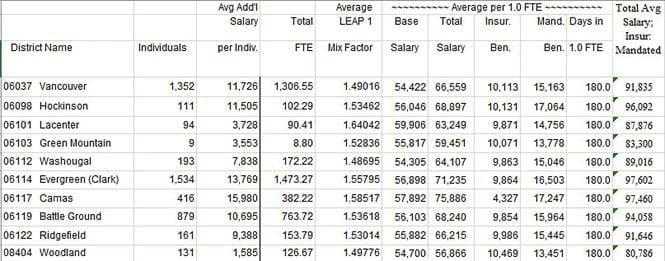‘In the end, no matter how harsh it may seem, we need to ask what we can afford and then live within our means’
The teachers are right to strike and demand a 20-30 percent salary increase. Or, the teachers are striking illegally and don’t deserve a big raise.

Battle Ground
Teachers are overworked and should be paid better. Or, teachers only work 180 days a year so they are really being paid double what they say they make.
The legislature allocated $1 billion for increasing salaries for teachers. Or, the $1 billion was to help increase salaries but also cover the losses due to levy reductions.
Teachers are saints. Or, teachers are well paid public employees who complain a lot.
Who’s right? Who’s wrong? The answer is … yes and no and both.
Taxpayers have seen dramatic increases in their school property taxes. School taxes are now tied totally to assessed property value. As values rise taxes go up. When the next downturn happens (it’s just a matter of time) revenues for schools are going to drop like a rock. Local levy reductions are going to result in district income drops that can be $10-$20 million or more. State increases in funding may offset some of the losses …at least for a year or two.
Teachers feel like they sacrificed during the 2007-2008 recession and want to be compensated and catch back up. Workers in other industries have also suffered and have never recovered. Private industry workers are not seeing the types of raises teachers are demanding. Healthcare and retirement for employees of businesses are not always as well off as public employees.
Teachers say school districts are hiding money and spending too much on administration and not paying teachers well enough. Districts (School Board directors to be honest) say they are trying to pay teachers well but also need to pay all the other bills.
This is an emotional issue but should be one of the head and not the heart. Children should not be used as pawns. From OSPI’s own documents, here’s a snapshot of the salary, insurance and mandated benefit dollar values as of the 2017-2018 time frame. Judge for yourself if these numbers are just OK or excellent. But … remember that the target 15 percent (or more) salary increase being demanded also includes a similar benefit increase target so multiply these “averages” by the actual increase to get current numbers.
Let’s take the best paid district by average: Evergreen at $97,602. That number is comprised of an average base salary of $56,898 multiplied by a mix factor of 1.55795 = $71,235. Wait…what’s a mix factor? Answer: The tenure and education level. The higher the multiplier the more years of experience and/or advanced education. A larger number generally means more experienced teachers. Add to the $71,235 the Insurance Benefit value ($9,864) and the Mandated Benefits (sick leave, maternity leave, retirement, etc.) of ($16,503) and the fully loaded average cost is $97,602.
So what if the teachers negotiate a 15 percent raise? (Note: It appears the unions are seeking a 15 percent increase in benefits as well.) What if they get both? Salary $71,235 x 1.15 = $81,920. If that’s all they got then the value of the package increases to $108,287. What if the benefits also go up 15 percent? To be conservative let’s assume only the Insurance Benefit increases. That = $9,864 x 1.15 percent = $11,343 (up $1,479). Add that to the $108,287 = $109,766. Remember that these are averages. Some are much lower and some are higher. In this example (and it is merely an example) the actual 1-year increase would be 12.46 percent.
The State has already said what the increases for the next three years (starting in 2019/2020) are: 1.9 percent; 1.9 percent and 2.0 percent. (If inflation is higher those rates may increase)
Is this sustainable? The Seattle Times (a very liberal paper) ran a recent article saying ‘’No.’’ In the next 2-3 years, based on current numbers most districts will run deficits.
There is one more piece (at least one) to the puzzle. Every school district in southwest Washington has more employees than the state pays for. In the past, those extra people were paid through the levy. Starting Jan. 1, 2019, that stops. All personnel will need to be paid out of the state money. If a district has 15 percent more people than the state has covered those people must now be paid out of that extra money the state gave (the $1 billion you hear about). So if a district has 1,000 people and 150 of those were paid through the levy and if that was a teacher using the “average” compensation of the newly negotiated $109,766 that would equal $16,014,900 in new expense out of state supplied money. Keeping those people has huge budget implications in the future.
Indeed, districts may be forced to reduce the number of extra personnel they employ to balance the budget. Large raises today hasten the deficit and need to trim personnel/cut expenses.
We all want the best possible education for our children. We want great teachers. We want our teachers to earn a good living. In the end, no matter how harsh it may seem, we need to ask what we can afford and then live within our means. Each voter and taxpayer needs to study this closely and make their own decisions.
Dick Rylander
Battle Ground





